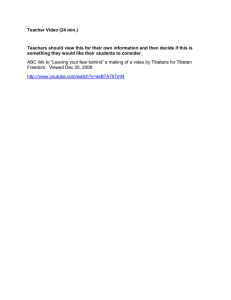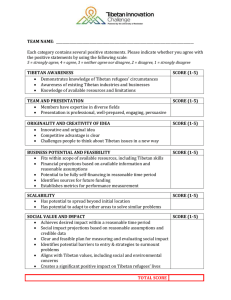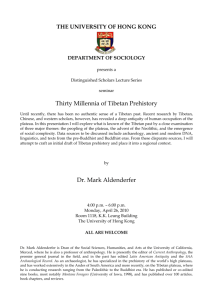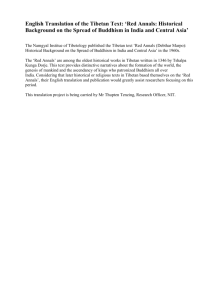Introduction - Princeton University Press
advertisement
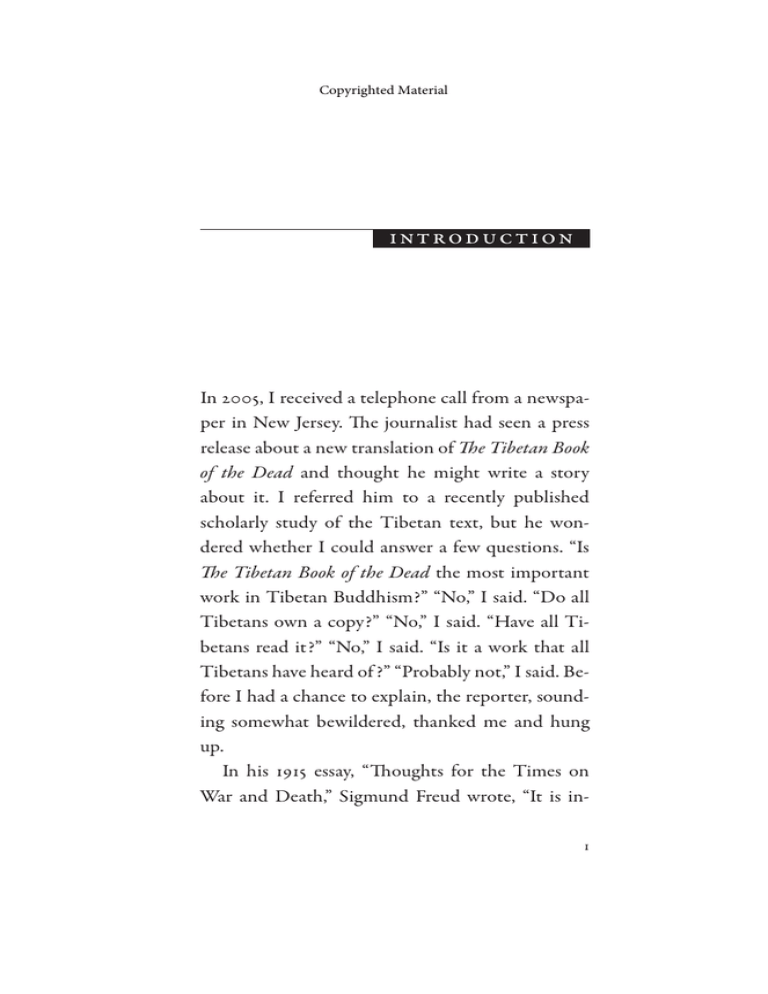
Copyrighted Material I n t ro d u c t io n In 2005, I received a telephone call from a newspaper in new Jersey. The journalist had seen a press release about a new translation of The Tibetan Book of the Dead and thought he might write a story about it. I referred him to a recently published scholarly study of the tibetan text, but he wondered whether I could answer a few questions. “Is The Tibetan Book of the Dead the most important work in tibetan Buddhism?” “no,” I said. “Do all tibetans own a copy?” “no,” I said. “Have all tibetans read it?” “no,” I said. “Is it a work that all tibetans have heard of ?” “Probably not,” I said. Before I had a chance to explain, the reporter, sounding somewhat bewildered, thanked me and hung up. In his 1915 essay, “Thoughts for the times on War and Death,” Sigmund Freud wrote, “It is in1 Copyrighted Material deed impossible to imagine our own death; and whenever we attempt to do so we can perceive that we are in fact still present as spectators.”1 Four years later, the American Theosophist Walter EvansWentz, traveling in the Himalayas, chanced upon a tibetan text and asked the English teacher of the Maharaja’s Boarding School for boys in Gangtok, Sikkim to translate it for him. What is known in the Wes t as The Tibetan Book of the Dead is the product of their collaboration. The tibetan work that was given this name by Evans-Wentz is one of many Buddhist texts known by the title Bardo Tödöl (in transliterated tibetan, Bar do thos grol,2 literally, “Liberation in the Intermediate State through Hearing”). It belongs to the genre of tibetan literature called terma (gter ma) or “treasure.” It is said to have been composed by the great Indian tantric master Padmasambhava, who visited tibet in the eighth century. Knowing that his teachings would be needed in the distant future, he dictated books to his consort and scribe (the queen of tibet) and buried them—sometimes in a cave, sometimes in a lake, sometimes in a pillar, sometimes in the heart of a disciple yet unborn—to await discovery when the time was ripe for their contents to be reve aled to the world. He compo sed thousands of such works. The book called Bardo 2 introduction Copyrighted Material Tödöl, buried in the eighth century, had been unearthed in the fourteenth century. Evans-Wentz would discover that tibetan text in the twentieth century and, burying it under prefaces, commentaries, introductions, and annotations, he named it The Tibetan Book of the Dead. Since its publication in 1927, the book has been discovered by millions of readers in the West who have used it to do what Freud deemed impossible: imagine their own deaths. Once it had appeared in English with this title, The Tibetan Book of the Dead would go on to have its own series of discoveries in the West, over the course of almost a century. Seven major reincarnations (and several minor ones), seven discoveries of this text, each somehow suited for its own time, have occurred in English since 1919.3 From the time of its first incarnation in a Western language, The Tibetan Book of the Dead has taken on a life of its own as a timeless world spiritual classic. It is the first Asian text, and the only tibetan text, to have been selected for inclusion in this series on the Lives of Great Religious Books. The worldwide fame of The Tibetan Book of the Dead, regardless of the form the title has taken, derives directly from Evans-Wentz’s volume, which has served as the progenitor of the later versions, to introduction 3 Copyrighted Material a greater extent than even the “original” tibetan text. His book itself has had a number of reincarnations, in the form of editions, each with more and more prefaces and forwards added to the text. Since its publication by Oxford University Press, the various editions have sold over 500,000 copies in English; it has also been translated into numerous European languages. Its full title is The Tibetan Book of the Dead; or, The After-Death Experiences on the Bardo Plane, according to Lāma Kazi Dawa-Samdup’s English Rendering. It was “compiled an dedited by W. y. EvansWentz.” This was the first of four books on tibetan Buddhism that Evans-Wentz would produce, from translations made by others. In 1928, the year following the publication of The Tibetan Book of the Dead, Evans-Wentz brought out Tibet’s Great Yogī Milarepa followed by Tibetan Yoga and Secret Doctrines in 1935, both based on translations by Kazi Dawa Samdup. The fourth and final work did not appear until much later. This was The Tibetan Book of the Great Liberation—based on translations done for Evans-Wentz by three Sikkimese—which was published in 1954.4 The first edition of The Tibetan Book of the Dead contained a “Preface to the First Edition” by EvansWentz as well as a foreword entitled, “Science of 4 introduction Copyrighted Material Death” by Sir John Woodroffe, an official of the British Raj who during his time as Judge of the High Court of Calcutta had become a scholar and devotee of Hindu tantra, publishing such works as The Serpent Power under the pseudonym Arthur Avalon. In addition, there was Evans-Wentz’s own extensive introduction and copious annotations to Kazi Dawa Samdup’s translation. The second edition (1949) included an additional preface by Evans-Wentz. The third edition (1957) brought the book close to the form in which it is best known today, adding a “Psychological Commentary” by C. G. Jung, translated by R.F.C. Hull from the original German version that appeared in Das Tibetanische Totenbuch, published in Zurich in 1935. The third edition also contained an Introductory Foreword by Lama Anagarika Govinda. Evans-Wentz added a preface to the first paperback edition (1960). And it was published yet again in 2000, “with a new Foreword an dAfterword by Donald S. Lopez, Jr.” Thus, although the first sentence of Evans- Wentz’s preface to the first edition reads, “In this book I am seeking—so far as possible—to suppress my own views and to act simply as the mouthpiece of a tibetan sage, of whom I am a recognized disi o fthe book that we have today is ciple,”5 the ver s on filled with other voices (the various prefaces, introintroduction 5 Copyrighted Material ductions, forewords, commentaries, notes, and addenda comprise some two thirds of the entire book) that together overwhelm the translation. The increasing popularity of the work compelled this unusual assortment of authorities to provide their own explanation of the text. This amalgam of commentaries, surrounding a translation of several chapters of a much larger tibetan work, has become the most widely read “tibetan text” in the West. Its appeal derives from the irresistible combination of two domains of enduring fascination: tibet and death. At the time of the publication of The Tibetan Book of the Dead, tibet, still a remote land in the high Himalayas, was regarded by many as a place where esoteric wisdom, long since lost elsewhere, had been preserved. Bounded on the south by the highest mountains in the world, at a time when mountains signified a cold and pristine purity, tibet was imagined as a domain of lost wisdom. tibet’s geographical inaccessibility was not the only reason for this view. Of perhaps equal importance was the fact that tibet had never come under European control, and as a result, many of the European fantasies about India and China, dispelled from these lands by colonialism, made their way across the mountains and became sited in an idealized tibet. Evans-Wentz never 6 introduction Copyrighted Material entered tibet, which in 1919 was largely inaccessible to Westerners. He remained instead on the borderlands, left to imagine what lay beyond the snowy range. Even greater than the lure of tibet is the eter- nal fascination with death. When Freud asserted that it is impossible to imagine one’s own death, what he meant by death was the cessation of mental functions. But in the Buddhism of tibet, consciousness never ceases, but passes through birth, death, the intermediate state or bardo (a tibetan term that,as a result of Evans-Wentz’s book, found its way into Webster’s Third New International Dictionary), and rebirth, over and over again, until the achievement of buddhahood. Much of the allure of The Tibetan Book of the Dead can be attributed to the fact that it was the first work to offer an extended discussionof the Buddhist doctrine of death and rebirth toa large audience in the West, a doctrine elaborated in the tibetan text with detailed descriptions of visions of peaceful and wrathful deities that appear in the nether world between death and birth. Thisvision of the afterlife found a ready audience during a different intermediate state, the period between the world wars. The late nineteenth century had been the heyday of Spiritualism, where mediums claimed to contact the spirits of the deintroduction 7 Copyrighted Material parted. Spiritualism experienced a revival after the First World War, when so many sought to know the fate of their lost fathers, sons, brothers, and husbands. Sir Arthur Conan Doyle, for example, turned to Spiritualism and sought to contact his son Kingsley, who died as a result of wounds suffered at the Battle of the Somme, while Freud wrote Thoughts for the Times on War and Death in 1915 as two of his sons served in the German army. The publication of The Tibetan Book of the Dead in 1927 preceded by two years the onset of the Great Depression, a period of profound anxiety in Europe and America about the future of the living. An ancient tibetan text that described the post-mortem state in such precise and elaborate detail, and which explained that death was not an end, but a beginning, and that death was, indeed, an opportunity for enlightenment, offered both fascination and comfort. yet beyond the historical exigencies of its publication, The Tibetan Book of the Dead has proved remarkably resilient in subsequent generations, gaining far more readers in its English version (with subsequent translations into other European languages) than the tibetan text—upon which it is based—ever had in tibet. And it has been put to a remarkable range of uses. It inspired timothy Leary, 8 introduction Copyrighted Material Ralph Metzner, and Richard Alpert to publish The Psychedelic Experience: A Manual Based on the Tibetan Book of the Dead in 1964, a work in whic hthe traditional teachings on the journey from one lifetime to the next were adapted into an instructional manual for an acid trip. Their book is largely forgotten today, except among true devotees of the Beatles, who know that the opening lines of “tomorrow never Knows” on the 1966 album Revolver come from this book, “Whenever in doubt, turn off your mind, relax, float downstream.” In his 1966 recording, OM, John Coltrane and Pharaoh Saunders read aloud from The Tibetan Book of the Dead. In 1975, Stephen Levine and Richard Alpert, by now known as Baba Ram Dass and no longer an apostle of LSD, founded the Living/Dying Project in San Francisco, in which the dying were read passages adapted from The Tibetan Book of the Dead. In the 1990 film, Jacob’s Ladder, a Vietnam veteran experiences disturbing hallucinations, and the viewer, like the protagonist, is unable to distinguish reality from illusion. At the end, it is revealed that the entire film has been the visions of an American soldier in Vietnam as he dies on the operating table. He is finally led into the light by a child. The director Adrian Lyne explained in interviews that the film had been inspired by The Tibetan Book of the Dead. today, in introduction 9 Copyrighted Material addition to various translations, one can purchase an audio version of The Tibetan Book of the Dead, read by Richard Gere; a video dramatization of The Tibetan Book of the Dead, including film footage from Ladakh and an animated depiction of the state between death and rebirth, narrated by Leonard Cohen; The Tibetan Book of the Dead for Reading Aloud adapted by the playwright Jean-Claude van Italie; and a comic book version, The Comic Bardo Thodol by Thomas Scoville. An hour-long documentary on The Tibetan Book of the Dead aired in January 2007 as part of the History Channel’s “Decoding the Past” series. In a footnote to his introduction, Evans-Wentz writes that he and Kazi Dawa Samdup felt, “that without such safeguarding as this Introduction is intended to afford, the Bardo Thödol translation would be peculiarly liable to misinterpretation and consequent misuse . . .” (1) They could have had little idea of the myriad ways in which their collaboration would be read. Removing the Bardo Tödöl from the moorings of language and culture, of time and place, Evans-Wentz transformed it into The Tibetan Book of the Dead and set it afloat in space, touching down at various moments in various cultures over the course of the past century, providing 10 introduction Copyrighted Material in each case an occasion to imagine what it might mean to be dead. This book tells the strange story of The Tibetan Book of the Dead. It argues that the persistence of its popularity derives from three factors, two of which have been already mentioned. The first is the human obsession with death. The second is the Western romance of tibet. The third is Evans-Wentz’s way of making the tibetan text into something that is somehow American. Had the reporter stayed on the line with me in 2005, I would have explained why my answer to each of his questions was “no.” I would have told him that the work by Walter Evans-Wentz entitled The Tibetan Book of the Dead is not really tibetan, it is not really a book, and it is not really about death. It is about rebirth: the rebirth of souls and the resurrection of texts. Evans-Wentz’s classic is not so much tibetan as it is American, a product of American Spiritualism. Indeed, it might be counted among its classic texts. I would have told him that The Tibetan Book of the Dead is a remarkable case of what can happen when American Spiritualism goes abroad. Like many tales, the tale I will tell involves a journey to strange lands with ancient masters, secret introduction 11 Copyrighted Material teachings, and buried texts. But we sometimes forget that America has also been deemed sacred by some, that American soil has also yielded sacred texts. We will arrive in tibet soon enough. But our journey begins in America. 12 introduction
